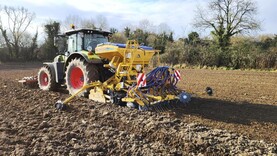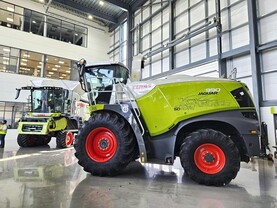Automatic assistance systems designed to maximise the potential of machinery are now part and parcel of many modern combines and foragers, but Claas says that the degree of automation is set to increase in the next few years.
The German machinery giant says that with the incoming automation, there will be periods when operators have so little to do, even in terms of supervision, that they will feel underworked and tire quickly.
As a result, it says the cabs in future harvesting machines must enable operators to perform other activities in addition to those relating specifically to the machine.
Cab 4.0
The Cab 4.0 project was launched in 2019 and is being developed by five companies and institutions, including Claas.
The research project uses the latest technology such as joystick steering, operator fitness detection and eye tracking in the cab to show what the future workplace might look like.
This concept features innovative equipment with internet connection and different human-machine interfaces such as cameras, head-up displays, monitors, keypads and more.
With this equipment, Claas says it is possible to continuously monitor the operator's occupation level and establish two-way communication. When operators are underworked, the system suggests alternative tasks and activities for them to do.

Claas says it is possible to continuously monitor the operator's occupation level and thus establish two-way communication.
It says the core element is a virtual assistant supported by an eye tracker in the roof, which speaks to the operator when signs of fatigue are detected and recommends appropriate action.
At the press of a button, the operator can adjust the seat to three positions to carry out these actions. The seat faces forward in work mode, but can be swivelled to the left for relaxation mode. In this position, the operator can perform light gymnastic exercises.
Alternatively, on the head-up display they can find information about relaxation, watch tutorials or do personal work.
Sending emails
In office mode, the seat is swivelled to the right, so the operator can see the head-up display on the right-hand window.
In this position, they can place a portable tablet between the armrests to do office work such as emails, planning, documentation and controlling work in the farm management system.
Claas says the harvesting machine must be equipped with automatic front-area monitoring for the new Cab 4.0 functions to work effectively in the field.

Cab10Future is the long-term Claas vision of a cab for tractors and harvesting machines.
The operator is notified in good time of any obstacle detected by the front-area monitoring system so that they can return to work mode and supervise the steering of the machine.
Cab 10 Future
With its Cab 10 Future, Claas unveils its own vision of the future cab. This includes more comfortable workspace with a seat that rotates by up to 60° in both directions for close-up work.
It also includes intelligent lighting for a relaxed working environment, large screens in the front focus area for digitisation and sustainable construction, with replaceable wear-prone modules and use of recycled materials.
Transparent A-pillars with cameras and displays reflect the environment, while Claas says the absence of a steering column (autonomous operation) creates an impressive spatial experience for the operator.
It will feature 360° exterior lighting to simplify external machine communication.
Automatic assistance systems designed to maximise the potential of machinery are now part and parcel of many modern combines and foragers, but Claas says that the degree of automation is set to increase in the next few years.
The German machinery giant says that with the incoming automation, there will be periods when operators have so little to do, even in terms of supervision, that they will feel underworked and tire quickly.
As a result, it says the cabs in future harvesting machines must enable operators to perform other activities in addition to those relating specifically to the machine.
Cab 4.0
The Cab 4.0 project was launched in 2019 and is being developed by five companies and institutions, including Claas.
The research project uses the latest technology such as joystick steering, operator fitness detection and eye tracking in the cab to show what the future workplace might look like.
This concept features innovative equipment with internet connection and different human-machine interfaces such as cameras, head-up displays, monitors, keypads and more.
With this equipment, Claas says it is possible to continuously monitor the operator's occupation level and establish two-way communication. When operators are underworked, the system suggests alternative tasks and activities for them to do.

Claas says it is possible to continuously monitor the operator's occupation level and thus establish two-way communication.
It says the core element is a virtual assistant supported by an eye tracker in the roof, which speaks to the operator when signs of fatigue are detected and recommends appropriate action.
At the press of a button, the operator can adjust the seat to three positions to carry out these actions. The seat faces forward in work mode, but can be swivelled to the left for relaxation mode. In this position, the operator can perform light gymnastic exercises.
Alternatively, on the head-up display they can find information about relaxation, watch tutorials or do personal work.
Sending emails
In office mode, the seat is swivelled to the right, so the operator can see the head-up display on the right-hand window.
In this position, they can place a portable tablet between the armrests to do office work such as emails, planning, documentation and controlling work in the farm management system.
Claas says the harvesting machine must be equipped with automatic front-area monitoring for the new Cab 4.0 functions to work effectively in the field.

Cab10Future is the long-term Claas vision of a cab for tractors and harvesting machines.
The operator is notified in good time of any obstacle detected by the front-area monitoring system so that they can return to work mode and supervise the steering of the machine.
Cab 10 Future
With its Cab 10 Future, Claas unveils its own vision of the future cab. This includes more comfortable workspace with a seat that rotates by up to 60° in both directions for close-up work.
It also includes intelligent lighting for a relaxed working environment, large screens in the front focus area for digitisation and sustainable construction, with replaceable wear-prone modules and use of recycled materials.
Transparent A-pillars with cameras and displays reflect the environment, while Claas says the absence of a steering column (autonomous operation) creates an impressive spatial experience for the operator.
It will feature 360° exterior lighting to simplify external machine communication.








 This is a subscriber-only article
This is a subscriber-only article










SHARING OPTIONS: